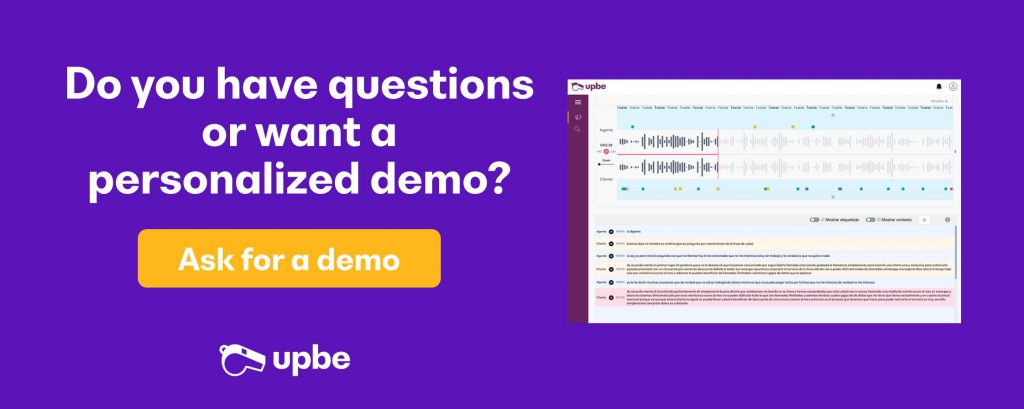
Whether it’s resolving inquiries, addressing complaints, providing technical support, or driving sales, excellence in call quality is a differentiating factor that can propel a company to success or lead it to decline. In this regard, quality analysis tools for call centers are essential as they provide the ability to measure, monitor, and improve the quality of customer interactions.
In this blog article, we will explore the basics of call quality and why effective quality control in the call center is crucial. Adopting these tools not only allows organizations to identify and resolve issues but also opens the door to continuous improvement in customer service. We hope to provide you with an insightful understanding of how these tools can become strategic allies for your call center.
Call Center Call Analysis. Definition.
Quality analysis in call centers is a strategic process that aims to align customer interactions with the organization’s business objectives. Its main objective is to identify common customer issues and improve their experience through standardized communication processes. Through regular quality control testing, continuous performance improvement is sought, along with a deep understanding of customer satisfaction.
Quality control in call centers allows for optimization in various areas, from scheduling and routing strategies to employee training and business processes. By improving agent performance and maximizing customer satisfaction, call volumes are reduced and key performance indicators such as Net Promoter Score (NPS) and Customer Satisfaction (CSAT) are enhanced. It is an essential practice to ensure efficiency and consistency in call center operations and meet customer expectations.
How is call analysis conducted?
Call analysis is typically the responsibility of the team leader, quality control specialist, or call center quality analyst.
When conducting the evaluation, two main categories of data, also known as quality parameters, are taken into account:
- Call and customer metrics: These metrics include average response time, call handling time, customer satisfaction ratings, Net Promoter Score (NPS), Customer Satisfaction (CSAT) scores, productivity metrics, among others. These metrics provide a quantitative view of call quality and help identify areas for improvement.
- Quality control assessment: This assessment involves reviewing samples of customer interactions to measure issue resolution and the level of professionalism displayed by agents. Team leaders or quality control specialists perform this assessment using a pre-agreed scoring framework. They evaluate factors such as the agent’s ability to understand and address customer needs, the clarity and effectiveness of communication, and compliance with established quality standards. This qualitative assessment provides a more detailed insight into call quality and enables the identification of individual areas for improvement for agents.
When conducting the evaluation, two main categories of data, also known as quality parameters, are taken into aOn the other hand, to achieve sustainable success in call centers, three main methods of quality control are employed: operational, tactical, and strategic. These methods are combined in different ways to manage quality throughout the organization.
Operational
It focuses on measuring key performance indicators of customer service on a daily basis. This approach emphasizes the daily tasks of the call center, evaluating the performance of both agents and the center as a whole. Through constant monitoring and data analysis, underperforming agents are identified, and compliance with established goals is verified. However, this approach has limitations as it does not provide a comprehensive view of underlying problems and difficulties. Therefore, it is necessary to complement operational quality control with additional approaches that address root causes and promote sustainable improvements in the call center.
Tactical
It focuses on addressing general concerns that impact customer service with the aim of improving overall quality. This approach centers on identifying and addressing the underlying causes of underperformance, such as low customer satisfaction rates, deficiencies in agent training, and the efficiency of team workflows. Although tactical solutions may require more time and resources, they provide long-term improvements and strengthen the team as a whole.
Strategic
This approach focuses on ensuring alignment between the call center and the organization’s overall business objectives. Led by top management, this approach addresses broad issues related to culture, standards, and organizational goals as a whole. It seeks to more effectively integrate customer service into business objectives, improve the customer service strategy to enhance customer loyalty and retention, and enhance employee retention in the contact center. Similar to the tactical approach, the strategic approach seeks long-term solutions to business challenges, contributing to sustained growth and ongoing success of the organization.
Quality analysis tools for call centers
Quality audits
Audits involve randomly listening to calls to identify areas for improvement and highlight agent strengths. They also enable the implementation of customizable surveys and dashboards to quickly evaluate agent performance. These practices help improve customer service quality and maintain high levels of satisfaction in a competitive environment.
Management software automates tasks, collects and analyzes data, records conversations, and offers key features such as automatic call recording, voice and call analysis, and omnichannel support.
Call recording analysis
Call recording has become an essential tool in call centers to assess agent performance and customer satisfaction. Various aspects of each call, such as duration, tone, and resolution, can be analyzed. In addition to phone calls, interactions in other channels can also be recorded. This information provides opportunities to enhance agent communication skills, provide more effective responses to customer inquiries, and optimize training programs.
Customer satisfaction surveys
Customer satisfaction surveys are essential in call centers to evaluate the quality of service provided by agents. These surveys collect feedback and opinions from customers, identifying areas for improvement and highlighting strengths. They offer a direct insight into the customer experience and satisfaction, covering aspects such as agent friendliness, problem resolution, and overall interaction quality. This data is vital for driving continuous improvements in customer service, enabling agents to adapt their approaches and skills, while allowing call center leaders to make informed decisions and develop strategies to elevate service quality.
Employee performance reviews
Employee performance evaluations are crucial for ensuring quality in a call center. They serve as a valuable tool to determine training needs for employees.
Supervisors assess calls and assign scores based on predefined criteria, contributing to professional development and continuous service improvement.
The use of agent monitoring software facilitates performance tracking, enabling real-time intervention and feedback to address issues promptly, resulting in ongoing performance and service quality enhancement.
Process mapping and improvement
This involves a thorough examination of each stage of your processes to identify challenges and improvement opportunities. It allows you to gain a clear understanding of your activities, identify potential issues, and implement enhancements. By optimizing your processes, you can streamline operations and provide a more satisfying service to your customers.
Artificial Intelligence and Machine Learning tools
The implementation of artificial intelligence (AI) and machine learning (ML) can have a revolutionary impact on call center operations. These technological tools enable the analysis of large volumes of call data, identifying patterns and emerging trends, which in turn leads to more accurate predictions about customer behavior, improved call routing, and enhanced personalization of customer service.
Quality analysis tools powered by AI and ML, such as those provided by Upbe, play a crucial role in improving customer service in telecommunications call centers. These tools provide valuable insights into agent performance and customer interactions, allowing companies to continuously improve and stay competitive in a dynamic market.
In the case of Upbe, we have a transcription engine specifically designed for the call center environment, understanding the complexity of phone conversations and enhancing the quality and accuracy of transcriptions.
AI and machine learning can act as true catalysts for change in the call center industry, enabling significant improvements in efficiency and the quality of customer service.
Are you ready to take the quality of your call center’s calls to the next level? Contact us and discover how Upbe can help optimize your processes and enhance your customers’ experience.

The evaluation of the quality of a call center is carried out through various methods and tools. One of the key approaches is call analytics, which involves listening to and reviewing interactions between agents and customers. Metrics such as response time, call duration, problem resolution, and customer satisfaction are examined. In addition, customer satisfaction surveys are used to collect direct feedback and assess perceived service quality. Another approach is to monitor agent performance through regular appraisals and quality reviews.
QA (Quality Assurance) in a call center refers to the analysis and quality control in interactions with customers. It is a strategic process designed to ensure that calls and other forms of communication are aligned with the organization’s business objectives and meet high quality standards. QA in a call center involves the systematic evaluation of calls, the monitoring and continuous improvement of agent performance, and the identification of areas for improvement in the customer experience. Through the use of specific tools and metrics, it seeks to optimize communication processes, provide exceptional service, and improve the efficiency and satisfaction of both agents and customers.
In a call center, various KPIs (Key Performance Indicators) or management indicators are measured to evaluate and monitor the performance and efficiency of the center. Some of the more common KPIs include average response time, which measures the time it takes for an agent to answer a call; call handling time, which calculates the total duration of the customer interaction; the Net Promoter Score (NPS), which assesses customer loyalty and satisfaction; the call abandonment rate, which indicates the percentage of calls that are abandoned before being answered; and First Call Resolution (FCR), which measures the ability to resolve a problem or query on the first call.
In call centers, various programs and tools are used to manage operations and improve the quality of service. One of the fundamental programs is call management software, which allows for the management of customer interactions, call routing, and queue management. In addition, call centers often use call recording programs, which capture and store conversations with customers for later review and quality analysis. Ticket or incident management systems are also used, which facilitate the management and monitoring of customer queries and problems. Other common programs include agent monitoring software, data analysis tools, and customer relationship management (CRM) systems.





1 Comment
Comments are closed.